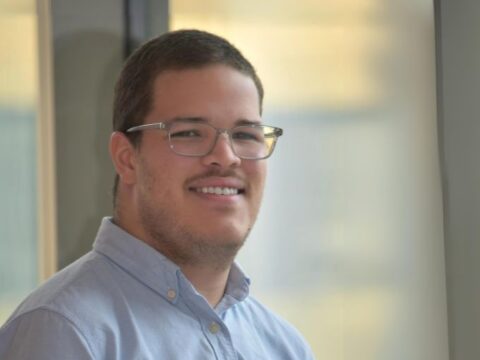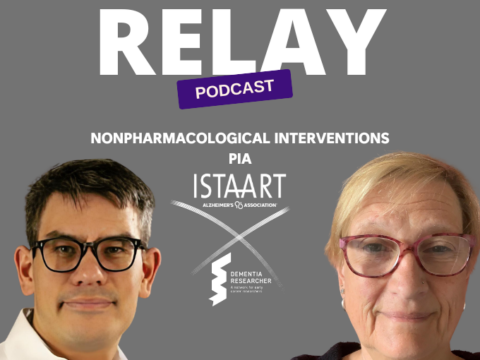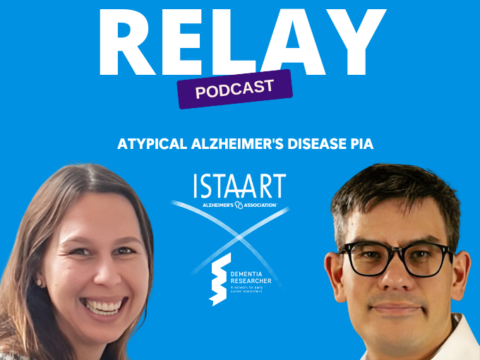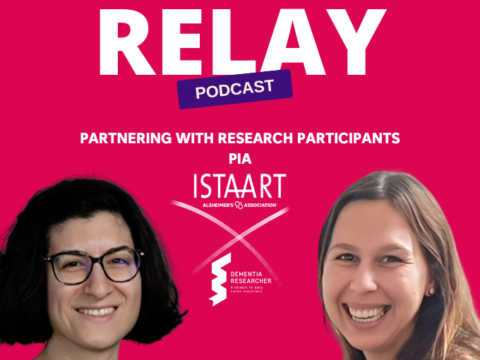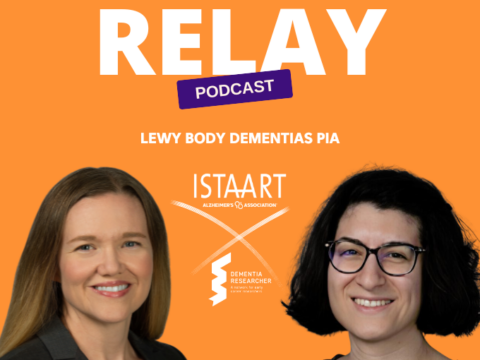The Dementia Researcher, ISTAART Relay Podcast is back for a fourth series. Five leading researchers discussing their research, their field, and the work of the Alzheimer’s Association ISTAART Professional Interest Area they represent.
EP1 – Dr Imre Lengyel interviews Dr Maura Malpetti, representing the Frontotemporal Dementia PIA.
Imre Lengyel is a Reader (Associate professor) at Queen’s University Belfast. Imre is researching how we could use the eye as a less expensive, better tolerated, and faster marker to monitor the progression of neurodegeneration. He undertakes clinical eye imaging and use postmortem tissues to generate molecular and high-resolution anatomical confirmation for the changes we see in eye images. Imre is representing the ISTAART The Eye as a Biomarker for AD PIA.
Maura Malpetti is a Race Against Dementia Fellow at University of Cambridge. Maura focusses on multimodal imaging techniques (multi-tracer PET and MRI) integrated with fluid markers, post-mortem validation, and prognostic modelling approaches in frontotemporal lobar degeneration. Maura is representing the ISTAART Frontotemporal Dementia PIA.
The Alzheimer’s Association International Society to Advance Alzheimer’s Research and Treatment (ISTAART) convenes the global Alzheimer’s and dementia science community. Members share knowledge, fuel collaboration and advance research to find more effective ways to detect, treat and prevent Alzheimer’s and other dementias. Professional Interest Areas (PIA) are an assembly of ISTAART members with common subspecialties or interests.
There are currently 29 PIAs covering a wide range of interests and fields, from the PIA to Elevate Early Career Researchers to Biofluid Based Biomarkers and everything in between.
To sign-up to ISTAART and a PIA visit:
https://istaart.alz.org
Note: ISTAART Membership is free for students worldwide, and for researchers of all levels based in Low- and Middle-Income Countries.
To book your place at this year’s AAIC (In-person and online) visit:
https://aaic.alz.org
Voice Over:
Hello, and thank you for listening to the fourth season of the ISTAART PIA Relay Podcast, brought to you by Dementia Researcher. ISTAART is a professional society and part of the Alzheimer’s Association representing scientists, physicians, and other dementia professionals active in researching and understanding the causes and potential treatments of Alzheimer’s disease and other dementias.
In this five-part series, we’ve asked members of the ISTAART Professional Interest Areas to take turns interviewing their colleagues and being interviewed themselves, with the interviewee going on to be the next episode’s interviewer. We’re sure you’ve listened to these before, so you’ll know what to expect. We’ll be releasing one of these podcasts each day in the buildup to the Alzheimer’s Association International Conference, which this year takes place online and in Amsterdam. So, sit back, turn up the volume, and be ready to hear about these individuals’ amazing research fields, the work of their peers, and just what you can expect at this year’s conference. Thank you for listening.
Dr Imre Lengyel:
Hello and thanks for tuning in. I’m Imre Lengyel, an associate professor at Queen’s University Belfast in the United Kingdom, and I’m the communication chair of The Eye as a Biomarker for Alzheimer’s Disease Professional Interest Area or PIA. Today, I’m delighted to be talking with Dr. Maura Malpetti from Cambridge, also from the UK just as myself. Hi, Maura.
Dr Maura Malpetti:
Hi Imre.
Dr Imre Lengyel:
Maura, can I start by asking you to tell us in which professional interest group you are involved?
Dr Maura Malpetti:
Well, first of all, thank you so much for interviewing me. It is great to be here and be interviewed by you. I’m the program chair of the Frontotemporal Dementia Related Disorder PIA, and today I think there will be the opportunity to speak a bit more about this particular PIA.
Dr Imre Lengyel:
Fantastic. Before we do that, Maura, I would love to hear a little bit about your own research.
Dr Maura Malpetti:
I am a Race Against Dementia and Alzheimer Research UK fellow at the University of Cambridge. And for my research, I focus on biomarkers in frontotemporal dementia and related disorders. And when we speak about related disorders, we refer very often to conditions like progressive supranuclear palsy and corticobasal syndrome or degeneration. These conditions are a bit different from Alzheimer disease. Some of them tend to appear a bit younger and they impact very different aspects. Memory can be part of the symptoms, but they mainly involve personality changes, behavioral changes, language difficulties, and also motor symptoms.
In comparison to Alzheimer disease, we still have very few biomarkers that are useful and very efficient in these conditions. For example, we cannot use much tax PET. There are only new tracers that seem to be working a bit better. But for example, amyloid PET can be used to differentiate these conditions from Alzheimer disease. But what we are really relying on is still MRI and FDG PET. And in Cambridge, we are looking at two aspects in particular, inflammation and synaptic loss, which seems to be present across all the spectrum independently from the clinical manifestation and the pathology underpinning these conditions. And we look at that with PET imaging, positron emission tomography, but also with fluid markers to see how these biomarkers can predict clinical outcomes in people with these conditions.
Dr Imre Lengyel:
This is very interesting. But I’m wondering, what brought you to dementia research?
Dr Maura Malpetti:
That’s a very interesting question. I was a very science-y kid. I really loved everything that was nature, like animals, and the body. And during high school, I really got fascinated about how the human body, and in particular, the brain, was working in biology class. And so, I started psychology. I studied bachelor in psychology to study more the interaction between mind and the brain. And during my study in psychology and neuropsychology, I discovered research, scientific research, and in particular, dementia. Basically, I got very fascinated by the brain and when the brain doesn’t work well. And it was very devastating seeing all these cases of people with dementia, how they were losing everything that they learned during life, changing personality, losing memory, or losing the capacity of speaking.
So, during my bachelor’s, I was very attracted to these aspects and then I continued my studies with a master’s in cognitive neurosciences. And I did my project for my master’s in nuclear medicine because I discovered neuroimaging during bachelor and master’s. And I was very fascinated that finally, you could look into the brain of people living with these conditions. So then after that, I moved to Cambridge for my PhD in clinical neurosciences because I really wanted to get deeper in the understanding of what was going wrong in the brain, and also to find potential good markers for clinical trials and new treatments for dementia. So yeah, I started from psychology and then I moved more on to molecular imaging. And now, I’m also introducing a bit of biology in my studies with fluid markers, postmortem studies.
Dr Imre Lengyel:
That’s very interesting to have such a comprehensive understanding of a particular disease. Maura, I was wondering, what is this Race Against Dementia fellowship? Would you tell us just a little bit about that?
Dr Maura Malpetti:
Race Against Dementia is quite unique because it gives good stability over five years for early-career researchers trying new ideas. It’s a great support in terms of both stability of salary and the project, and really pushes you to try new things, try to make mistakes, change direction. And the idea is to install Formula One mindset into research, and in particular, in dementia research. The founder is Sir Jackie Stewart, three-time world champion of Formula One, and he really cares, and he feels the urgency of finding a cure for dementia as his wife, Lady Helen, has a diagnosis of dementia. And so, we all feel the urgency. We share this urgency of accelerating dementia research, and Race Against Dementia has been absolutely fantastic in doing that and also creating opportunities for other career researchers.
Dr Imre Lengyel:
Does that mean that you are racing together with Sir Jackie Stewart in his cars?
Dr Maura Malpetti:
I would wish, I would wish. I think I cannot stand the chance. But yeah, I think we are racing together against dementia, and that is I think the most important race also for him at the moment. He’s very good and I think he always says that in his lifetime, he really wants to see the solution for dementia. So, we are really pushing harder to see that finishing line together.
Dr Imre Lengyel:
Fantastic. Now, Maura, as with many peers, we have this year’s Year in Review, and I was listening recently to your summary of the previous year, which was really fascinating and exciting. Obviously, it seems to me that there is a lot of development going on in frontotemporal dementia. In your view, what is the most exciting area that you believe is going to blossom in the near future?
Dr Maura Malpetti:
Well, for sure, I am a bit biased because my main focus is inflammation. I think inflammation has been overlooked for many years, and there has been an explosion in the last few years of potential new targets, new drugs, new biomarkers to measure inflammation and how inflammation can really accelerate the clinical decline of people with frontotemporal dementia.
But I think in general, the most exciting part of this field is that a lot of disciplines are getting together to find a solution. We have biologists interacting with psychologists, with medical doctors, with engineers, to find the best biomarkers and developing new drugs. There are a lot of clinical trials ongoing, especially in genetic FTD, genetic frontotemporal dementia. So, I think we are very close to solving maybe genetic frontotemporal dementia, and from there, probably to learn something to expand in the sporadic cases. So yeah, I think the development of biomarkers and the new drugs that we can test with these biomarkers is the most exciting part of this particular period of the research field.
Dr Imre Lengyel:
There are a lot of excitement about the new clinical trials for Alzheimer’s disease as well, and some of the drugs are now being trialed. In your view for frontotemporal dementia, what is the timescale that you would hope to see some treatment on the market?
Dr Maura Malpetti:
It’s always tricky. It’s always difficult to answer a question about timeframe. Timeline is very difficult to say. The hope is always as soon as possible, especially because some of this condition progresses very quickly so people don’t survive very long. So, every year that we waste in not finding a cure or a treatment, it is one year less for them out of few years that they have left.
There is no specific timeline, but we have a lot of exciting clinical trials ongoing, as I said, in genetic FTD. And we also have a lot to learn from other diseases. Like of course Alzheimer disease, we cannot apply amyloid drugs, but we can learn from the clinical trials design of Alzheimer disease. And also, in motor neuron disorders. There are a lot of good clinical trials that we can learn from to apply in frontotemporal dementia. Or other conditions like multiple sclerosis for example, if we, for example, look at inflammation. So, I think it’s a very exciting period, and I hope very soon we’ll have good treatments to offer to people with dementia.
Dr Imre Lengyel:
That’s very interesting, and obviously there is a need for international collaboration. I presume that’s something that brought you to this particular professional interest area. Can you tell us a little bit about the discussions, if they’re not confidential, to our audience?
Dr Maura Malpetti:
Yes, absolutely. I think collaboration is really key in all dementia fields, but especially in conditions that are less common than, for example, family diseases like frontotemporal dementia, progressive supranuclear palsy, corticobasal syndrome. We really need to put all forces together across the world. There is a very big consortium out there that is trying to put together forces in genetic FTD, in progressive supranuclear palsy. For example, genetic FTD initiative is an example which is GENFI, the name, or ALLFTD is another example. And I think the FTD PIA really cares about this collaborative effort and this collaboration. And from some of the members, then we can learn a bit more about the members and how this is structured. But basically, they are a leading part of these worldwide initiatives. And we also collaborate quite closely with the International Society for Frontotemporal Dementia to bring together even more forces.
So, there are lots of discussions on how we can bring together even more possible opportunities to collaborate. Discussion also with other PIAs like the Diversity and Disparities PIA. This is very important because in frontotemporal dementia, we really don’t know how diversity impacts on the clinical outcomes. So, we are trying to put together some ideas on projects or potential reviews and discussions on how we can explore diversity in different countries. For example, considering different ethnicities, backgrounds, et cetera. And also, there has been some discussion with the PIA for clinical trials, advanced meta methods, to try to come together with new ideas on how we can accelerate the clinical trials in frontotemporal dementia.
Dr Imre Lengyel:
Okay. So, is this collaboration with the other PIAs you consider as an important part of the whole?
Dr Maura Malpetti:
Yeah. And I think also it’s very important because the FTD PIA is a platform. It’s where we can really bring together people from different fields and different disciplines. So even with webinars or discussions or the member meeting, that is twice a year we have member meetings, these are all opportunities to have conversations and discussion and potential new collaborations. And also, we really care about highlighting early-career researchers and their work. We have few initiatives about that, especially later this year because we really care about also the new generation of dementia researchers. And given that this Frontotemporal Dementia and Related Condition PIA is so young and is expanding so fast, we are already over 650 members, and we are really trying to bring everyone together and highlight in the new generation that maybe we find a cure.
Dr Imre Lengyel:
Oh, that sounds really exciting. And it’s fantastic to hear that you have such a dynamic group with I presume lots of early-career scientists joining. That brings me to the question, is that okay that you would tell us a little bit about the structure? Who else is involved in the PIA?
Dr Maura Malpetti:
Yes. This committee is composed of the PIA. I’m the programs chair, so I’m looking at contents, webinar, et cetera. Then we have the chair who is Jon Rohrer from UCL in the UK. We have a vice chair who is Vicky Fernandez Hernandez who was based in US and she’s moving very soon to Spain. Then we have a communication chair who is Carmela Tartagilia from Canada, and she’s also the communication chair of International Society Frontotemporal Dementia. So, we are collaborating very closely on that. And also, we have a postdoc member representative who is Lucy Chisman-Russell from London as well.
So, I think in comparison to other PIAs, our committee is very fluid. We don’t assign. There is a communication chair, of course, that has a specific task. I have a different task. But we really come together to bring all ideas. And some of them, for example, the postdoc member can create the contents of the webinar as much as the program chair. And as a programs chair, I can suggest things for Twitter or email as much as the communication chair. So, it’s very collaborative and all on the same level and floor.
Dr Imre Lengyel:
That’s really exciting. And I think you mentioned that you have a very dynamic group, so that means that you probably have lots of ideas. Would you tell us what you are planning to do in the coming year within your PIA?
Dr Maura Malpetti:
Yeah, of course. This year, this committee started last summer, the end of the summer, so in September. And this year, we already put together a few things. We hosted for example a journal club in October. It was meeting the authors. So, there were two early-career searchers, Siddharth Ramanan from Cambridge and Adit Friedberg from UCSF, who presented two very interesting papers published the year before. And they also moderated the chat and discussion with the authors and the audience. It was very interesting to hear.
And then we had in February Year in Review with Jackie Poos to basically revise all the FTD and Related Disorders papers of the previous year. We also had webinar about FTD basics in April with Carmela Tartagilia, which I suggest everyone to listen to and every student out there to look in on the ISTAART website because it was an absolutely outstanding lecture. And then we also had this webinar about Progressive Supranuclear Palsy and Not Just Richardson’s Syndrome with six early-career researchers speaking and three more senior moderators. It was excellent.
So, our promise is to this is just the basis and the basically next year we will propose very similar activities like the journal club, educational webinar, probably again something related to PSP and CBS, progressive supranuclear palsy and corticobasal syndrome. But yeah, we also have something coming up very soon that is in the conference, at the Association international conference. So, you should stay tuned. And if you have ideas, you are part of this PIA and you have ideas, just write to us. You are very welcome. You are very welcome to suggest anything, and we are always very happy to implement new ideas.
Dr Imre Lengyel:
So, Maura, not all of the listeners are necessarily members of any of these PIAs. You mentioned that these talks are available. Would you tell just a little bit of information to others that had to access these recorded presentations?
Dr Maura Malpetti:
Yes. On the ISTAART website, there is a long list of recorded webinars and events. And in general, they are uploaded around two weeks after the event itself. So, for example mid-April, you will have at the beginning of May available online. And you just need to click. For example, ISTAART PIA, frontotemporal dementia webinar, and you should find it. But you can also register for these webinars. They’re always online, live on Zoom in general. They’re free and everyone around the world can sign up, and they can just click if they are member or not at the moment of the webinars. It’s very good because we can reach all corners of the world because it’s online. We are always trying to be very fair with time zones. Sometimes, Australia is left out in terms of time zone. But for that reason, there is the recording and people can always catch up.
Dr Imre Lengyel:
Great. Now, you were very mysterious about what you are planning for the AAIC. Any hints that you could give us? Why would people look out specifically for the Frontotemporal Dementia PIA activities?
Dr Maura Malpetti:
Yeah, absolutely. We are starting actually before the conference itself on the day that precedes the conference. That is called the PIA Day, and we are participating. If you are around, that Saturday is the 15th of July, and our session will start at 2:45 PM local time. And it is very exciting because for the first time as PIA, we are presenting the Publication of the Year Award. It is the first time that we have done that. I will not tell you who won, but basically, we will have one of the authors presenting the work. And it was voted as best publication of the year related to some of that have been submitted for this award.
Then we will also have six talks from early-career researchers, a very competitive selection. We received a lot of submissions, and it was very good to see so much nice work out there. And we will also have a brief networking session. This is just before AAIC. But during the conference, we will also vote. For the first time, we will have a postdoc and student poster award. And so, we will have one for the postdoc and one for the students, and this will be announced after the conference. But we will come. If you see Carmela Tartagilia and me going around the posters, it’s because we are evaluating posters. There have been a lot of submissions as well. I would remind everyone next year when you submit the abstract for AAIC, you can click ISTAART FTD as a keyword, I believe, to be selected as part of this kind of awards and also for the first day, pre-conference day. So yeah, a lot of exciting things and very early career centric.
Dr Imre Lengyel:
Fantastic. Now, you talk a lot about what you are going to do at AAIC, but will you be presenting at the conference?
Dr Maura Malpetti:
Yes. I will present two abstracts, actually. One will be a poster and it will be my work in blood markers in frontotemporal dementia and related disorders and how this relates to PET with a focus on inflammation. And then I will also be part of FRS, which I believe is a future research session about inflammation. So about microglial activation, astrocytes. There will be four or five talks with very senior, other senior speakers. So, it will be very exciting. And I believe it’s on Monday. I’m very much looking forward to the discussion about inflammation, actually.
Dr Imre Lengyel:
If you don’t mind, it’s really a personal question because I’d like to understand a little bit more about your views on inflammation. We know that microglia are very much in focus at the moment on all diseases, but it’s somewhat more difficult to target a cell. Are there particular inflammatory processes, molecular processes that you think are very promising?
Dr Maura Malpetti:
There’s an excellent question. There are so many different aspects that we need to consider. We just started microglia activation, but there are also astrocytes ongoing. There are complement markers now that they are exploring as well. We are very interested to look at the storm of cytokines and chemokines, for example, and how the periphery interacts with the central inflammation. And it is a bidirectional talk. And for these we really need different types of biomarkers like PET that are super powerful and can measure one target with something that is a bit less specific, like blood markers or CSF markers, but can measure a lot of targets at the same time.
I think it’s a very dynamic process. We need so much information. And also very recently, we are starting a new network in the UK which is Open Network for Inflammation Research in Frontotemporal Dementia. We’re involving many centers across the UK, and the idea is looking at the immune system in people with frontotemporal dementia and how different background information and factors can influence these, and also in some way mediating the clinical outcomes. So, I think there is much more research coming in the next few years and exciting stuff.
Dr Imre Lengyel:
Very excited about your PIA’s work in general. Although I work on the eye and our PIA is using the eye as a biomarker, I have veered into frontotemporal dementia and the connection with the eye. And I think it’s going to be very exciting if these PIAs can start talking together to use each other’s expertise, especially since we are sharing so many similarities like the complement system’s role in all of them and other things. So, it’s a very exciting field and I must say the whole dementia research is a very exciting territory right now.
Dr Maura Malpetti:
And also, you mentioned AI, and I completely agree with you because now we are basically starting to have very big data in frontotemporal dementia as well. So of course, AI plays a crucial role in defining data-driven staging, data-driven approaches, and selection.
Dr Imre Lengyel:
I was wondering about that because obviously what you were telling so far, there are a lot of multi-modalities in researching the frontotemporal dementia. So, is there a particular grouping within your PIA or anywhere where you would be working with people in this domain?
Dr Maura Malpetti:
There are a few people that I know who are working on that. For example, Tim Rittman in Cambridge working on AI and how this can be applied to progressive supranuclear palsy, for example, detecting brain changes. In GENFI, there are many people looking at the pre-symptomatic phase of frontotemporal dementia. So, trying to identify with some data-driven approach the staging and the progression even before symptoms appear. And also, Jake Vogel for example, recently published some papers on these sustained approaches to see how we can stage based on MRI or the markers frontotemporal dementia progression. And these are just a few examples in the world that there are so many people, clever people, applying AIC and machine learning into these conditions. And I think it is very interesting. Of course, we would never try to replace a neurologist out there, but I think-
Dr Imre Lengyel:
That’s a political spin.
Dr Maura Malpetti:
But I think AI can be very good support.
Dr Imre Lengyel:
No, this is a very interesting topic. I often get this question that can we detect Alzheimer’s disease or dementia in the eye? And I keep telling them that even neurologists have a problem identifying disease when they study the brain, let alone when you are doing something different. So no, I agree with you. Probably we are not there yet, although the challenges with AI have been highlighted recently. So, it’s an interesting domain to watch.
Dr Maura Malpetti:
Yeah, absolutely. I agree.
Dr Imre Lengyel:
This was a very, very exciting discussion, Maura. And before I let you go, I wanted to ask a final question. If you asked that question why someone should sign up to your professional interest area, what would you tell them?
Dr Maura Malpetti:
Well, I hope that tonight, I convinced you how exciting is the field and also the FTD PIA group and how we are trying really to push on collaborations and new ideas, bringing together people, different disciplines, and also highlighting early-career researchers. So I really hope that everyone out there who has even just an interest about frontotemporal dementia, not necessarily working on frontotemporal dementia but wants to learn more with our educational webinars, or being part of the discussion with the member meetings beyond, well, member meetings, or even just being part of suggesting what we should focus on, I think you should just sign up and be part of the discussion. And they have new ideas out there. And if you have those ideas on potential collaborations with different centers or you know that maybe someone is in the FTD PIA and they have interest in data that you may look want to look at, we should just get together and have a chat. And if we can facilitate that, that is also part of the MO of this platform.
Dr Imre Lengyel:
Thank you very much. I must say the Year in Review of all these PIAs is actually fantastic. I don’t have to read all those papers. Someone else digested it for me, but it really gives a fantastic overview.
Well, thank you very much and I wish you all the best and enjoy Amsterdam. And I’d like to say to the audience that I’d like to thank Dr. Maura Malpetti for her time to join us today. And thank you all for tuning in. You can find profiles of myself and my brilliant guest and information on how to become involved in the ISTAART on our website at dementiaresearch.nihr.ac.uk, and also at www.alz.org/ISTAART. These links of course can be found in the notes below.
I’m Imre Lengyel and you’ve been listening to the Relay Podcast from Dementia Research and the Alzheimer’s Association. We will be back tomorrow. So hit Subscribe on YouTube or in your favorite podcast app to ensure you don’t miss an episode. Thank you. And thank you, Maura.
Dr Maura Malpetti:
Thank you so much.
Voice Over:
Brought to you by dementiaresearch.nihr.ac.uk in association with Alzheimer’s Research UK, Alzheimer’s Society, Race Against Dementia, and the Alzheimer’s Association, bringing new research, news, career tips, and support.
END
Like what you hear? Please review, like, and share our podcast – and don’t forget to subscribe to ensure you never miss an episode.
If you would like to share your own experiences or discuss your research in a blog or on a podcast, drop us a line to adam.smith@ucl.ac.uk
Did you know… you can find our podcast in your favourite podcast app on mobile devices, and our narrated blogs are also available as a podcast.
This podcast is brought to you in association with the Alzheimer’s Association, Alzheimer’s Research UK, Race Against Dementia and Alzheimer’s Society, who we thank for their ongoing support.
The views and opinions expressed by guests in this podcast represent those of the guests and do not necessarily reflect those of PIA membership, ISTAART or the Alzheimer’s Association.

 Print This Post
Print This Post